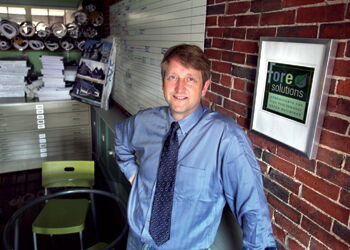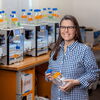LEEDing the way | Gunnar Hubbard, a pioneer in sustainable design, explains why it makes for smart business
 Photo/Tim Greenway
Gunnar Hubbard, principal and founder of Fore Solutions in Portland
Photo/Tim Greenway
Gunnar Hubbard, principal and founder of Fore Solutions in Portland
The grand opening of the Bosarge Family Education Center at the Coastal Maine Botanical Gardens on July 15 will represent more than a commitment to educating the public about the natural landscapes of Maine. The 8,400-square-foot educational building in Boothbay will be the first net-zero energy and LEED platinum commercial building in the state. (To see a photo slideshow of the new center, click here.)
LEED (Leadership in Energy and Environmental Design) is an internationally recognized green-building certification system, with four levels of certification: certified, silver, gold and platinum. LEED provides building owners and operators with a framework for identifying and implementing green building design. Such sustainable strategies are intended to improve performance in energy savings, water efficiency, carbon dioxide emissions reduction and indoor environmental quality.
As a net-zero-energy building, the education center at the botanical gardens will produce more energy than it uses on an annual basis. That’s impressive, considering the gardens are expected to host upwards of 100,000 people this year. It’s a project that Gunnar Hubbard, the principal and founder of Fore Solutions, a Portland consulting firm for green buildings that helped design the new center, is particularly excited about.
Since launching Fore Solutions in 2003, Hubbard has worked on other prominent sustainable buildings in Maine such as the Hannaford supermarket in Augusta, which also earned a platinum LEED designation. Considered a pioneer in the industry, Hubbard’s sustainable efforts span the globe with projects like the $9.4 billion hotel, retail and residential development of CityCenter in Las Vegas as well as residential towers in Amman, Jordan. But the botanical garden’s building is a project he’s particularly proud of. Mainebiz spoke with him about this project and the increasing number of business owners embracing sustainable building practices. Below is an edited transcript of a recent conversation:
Mainebiz: What is so special about the building at Coastal Maine Botanical Gardens?
Hubbard: This project represents a commitment the garden has made toward being an educational center, but the building itself is also a teaching tool, educating the public about energy consumption and sustainable building materials. It will have an electric dashboard that tells how much water is being used on a daily basis and the energy being generated, which will all be connected and posted on its website as well. We think that’s exciting. This kind of sustainability and green building practices falls in line with Maine values. It’s representative of who Maine is and its values.
What benefits can businesses expect from adopting sustainable practices?
When we talk about embracing sustainability, it can stretch in so many directions. Those businesses trying to use their buildings to be more efficient are benefiting from better quality work environments and air quality and lower utility bills, for example. The more efficiencies they embrace, the better off they are in the long run.
To me, what they’re trying to accomplish is a respect for the environment and respect for the people who work there and operate there and are affected by the business, and they understand the economic impacts in the short term and the long term.
What are the benefits of achieving LEED designation?
LEED has a lot of credibility and it helps streamline the process and push projects further using LEED as a tool, which is what it is. It’s just a measurement stick on how green a building is ... and we’re seeing more large corporations putting that mandate forward. They’re tracking the dollars spent on utility costs because it’s easier to put your finger on utility bills, but there are other benefits they’re seeing that are fuzzier, such as increases in worker productivity and reduced absenteeism because there’s more natural daylight and better air quality. In the corporate world, that’s translating to real dollars. We’re seeing more business owners who are excited about effecting change and embracing sustainable principles in how they do business. LEED is really just a designation of good design and construction.
What is the primary obstacle or concern for business owners considering LEED certification?
It always comes back to dollars. Many ask: ‘Why should I spend X amount of dollars on LEED and the necessary paperwork, rather than put that money into adding more insulation or something?’ There’s this tension there about why they need the certification when they would rather just construct a good green building. I think true sustainability doesn’t pencil out right away, in terms of investment. And while [return on investment] may be more than three or five years, just look at what they’re getting for that. When I talk about doing this, more often the discussion becomes: Why wouldn’t they do it?
How much more expensive is it to achieve LEED certification?
For LEED silver, we feel it is absolutely possible to do it without spending a dollar more on the brick-and-mortar part. If you want a LEED building and you hire a design team with that intention and contract with that intent, there’s no added cost. If you’re consistent from the beginning, LEED silver won’t cost any more than a regular building, and it translates to 20% or better efficiency than code would be, on average. There’s an admitted cost to documenting it, but that’s a soft cost and it really depends on the size of the project.
Now, for a gold or platinum designation, you’ll spend anywhere from 2% to 10% more. But if you do the math along the way in what you’re investing and spending, you can see where the return comes from. That’s where it comes back to economics and what the owner is willing to put on the table. If an owner wants to spend X amount of dollars per foot, that causes serious limitations. If they’re open-minded and an owner says ‘show me the numbers,’ they can get creative on financing because they see those returns and it’s a worthy investment.
What are some of the key elements of a successful project?
I think the biggest success comes from getting decision makers around the table. It’s one thing to talk to your development team, but if you don’t have that direct mandate from above to move forward, you are just going to be toe dipping. To be ultimately successful, you need the buy-in from everyone, and it’s our job to try to get the right information to the decision makers and help them arrive at decisions as simple as choosing the right sizing for the building, and even questioning the need for a new building or a major renovation.
More and more owners don’t know how to ask the right questions, and don’t hire the right services for good results. That’s where we’re effective and we can align owners to achieve the right goals. The biggest way we can be effective as a business is to get the design team and the contractor in the same room with the owner. We want to make sure those intense workshops and discussions and design efforts are done before anyone signs on the bottom line. That way owners end up learning what is possible. And often times the owner may say ‘We’re that close to LEED gold? What will it take to get to platinum?’
What new building designs or techniques are you particularly excited about?
[A lot of the innovation] comes from looking at solutions for building materials and the concept of biomimicry, which is the idea of mimicking nature in our selection of materials and solutions. The idea is that nature has been around a lot longer than us and we should turn to nature and learn from its example. A good example is a termite mound. Termites are able to maintain a certain temperature in their structures even in a desert environment by closing up their building during the day on the bottom and top. When the sun goes down, they go and open the top and bottom and let the hot air rise to the top and it pulls in the cooler air from the bottom. We’re depending on switches and dials to create comfort, and this is a concept on how to interact with a building and make it more responsive to our needs.
What would you like all business owners to know when it comes to sustainable building practices?
I think the point is that this is not something that “those people are doing over there.” This is something that everyone should be doing, even if it isn’t achieving LEED certification. LEED isn’t the only answer. It’s a matter of taking the steps to understand how to be more respectful in decision-making and thinking about sustainability and the environment as well as economics. Sustainability is a good, smart investment.
Leischen Stelter, a writer based in Portland, can be reached at editorial@mainebiz.biz.










Comments